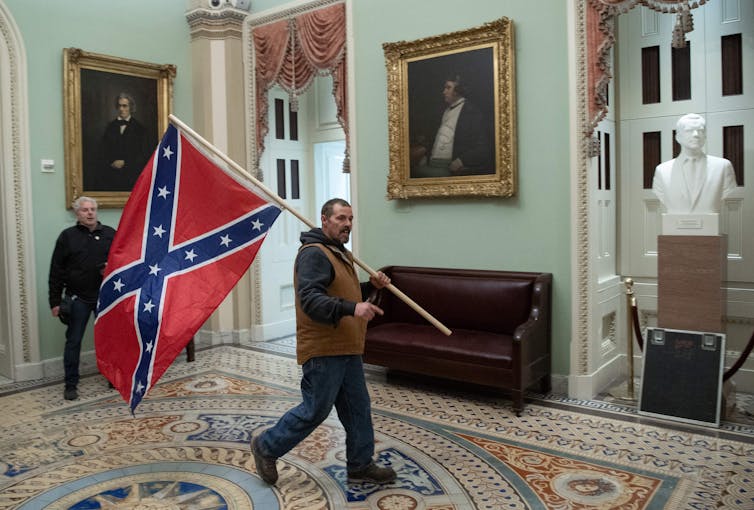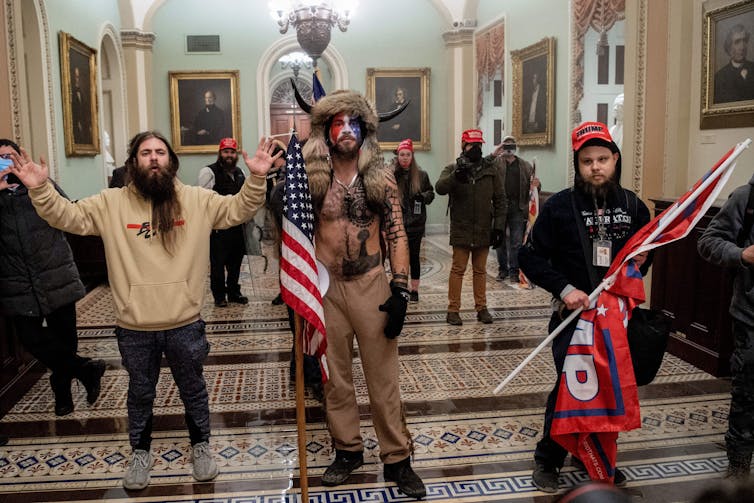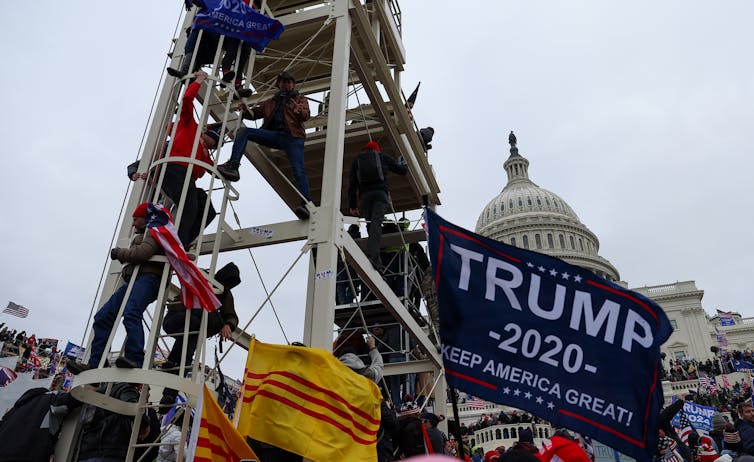Committee Report Focus 5 Essential Reads on the Symbols They Carried On Jan. 6
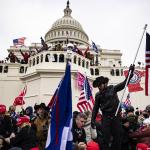
As the final report emerges from the congressional committee investigating the insurrection on Jan. 6, 2021, the focus is on the role of then-President Donald Trump and those close to him. That’s crucial information, but it leaves out another important chapter of the story.
There were thousands of people demonstrating on the streets of Washington, D.C., that day, whose actions are not recounted in detail in the congressional report. They carried a variety of political and ideological flags and signs. The Conversation asked scholars to explain what they saw – including ancient Norse images and more recent flags from U.S. history.
Here are five articles from The Conversation’s coverage, explaining what many of the symbols mean.
A man carries the Confederate battle flag in the U.S. Capitol on Jan. 6, between portraits of senators who both opposed and supported slavery. Saul Loeb/AFP via Getty Images
1. The Confederate battle flag
Perhaps the most recognized symbol of white supremacy is the Confederate battle flag.
“Since its debut during the Civil War, the Confederate battle flag has been flown regularly by white insurrectionists and reactionaries fighting against rising tides of newly won Black political power,” writes Jordan Brasher at Columbus State University, who has studied how the Confederacy has been memorialized.
He notes that in one photo from inside the Capitol, the flag’s history came into sharp relief as the man carrying it was standing between “the portraits of two Civil War-era U.S. senators – one an ardent proponent of slavery and the other an abolitionist once beaten unconscious for his views on the Senate floor.”
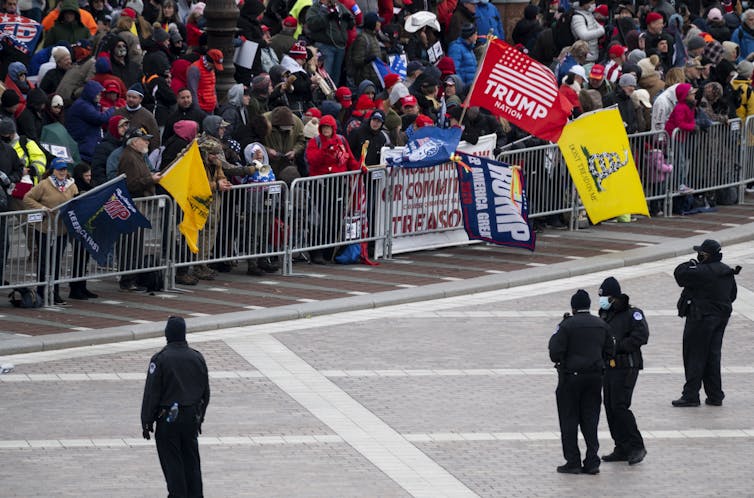
Gadsden flags fly at the Capitol on Jan. 6, 2021. Bill Clark/CQ-Roll Call, Inc via Getty Images
2. The yellow Gadsden flag
Another flag with a racist history is the “Don’t Tread On Me” flag. A symbol warning of self-defense, it was designed by slave owner and trader Christopher Gadsden when the American Revolution began, as Iowa State University graphic design scholar Paul Bruski writes.
“Because of its creator’s history and because it is commonly flown alongside ‘Trump 2020’ flags, the Confederate battle flag and other white-supremacist flags, some may now see the Gadsden flag as a symbol of intolerance and hate – or even racism,” he explains.
It has been adopted by the tea party movement and other Republican-leaning groups, but the flag still carries the legacy, and the name, of its creator.
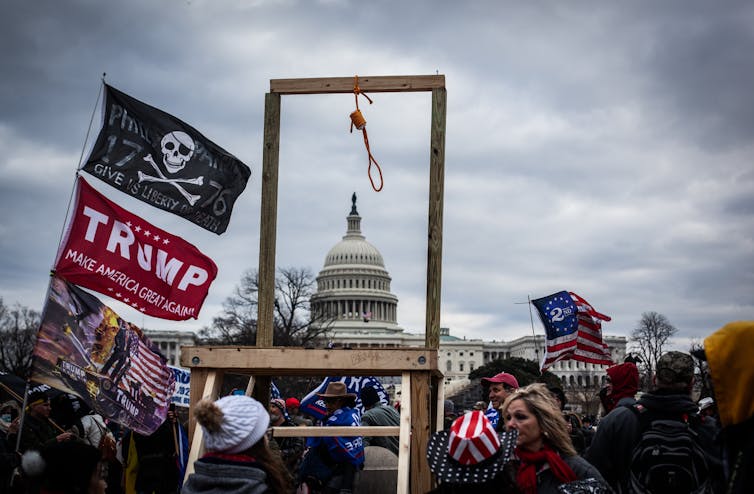
A gallows symbolizing the lynching of Jews was among the hate symbols carried as crowds stormed the U.S. Capitol on Jan. 6. Shay Horse/NurPhoto via Getty Images
3. Powerful antisemitism
Another arm of white supremacy doesn’t target Blacks. Instead, it demonizes Jewish people. Plenty of antisemitic symbols were on display during the riot, as Jonathan D. Sarna explains.
Sarna is a Brandeis University scholar of American antisemitism and describes the ways that “alls to exterminate Jews are common in far-right and white nationalist circles.” That included a gallows erected outside the Capitol, evoking a disturbing element of a 1978 novel depicting the takeover of Washington, along with mass lynchings and slaughtering of Jews.
A man known as Jake Angeli, now imprisoned for his role in the Capitol riot, wears a horned hat and tattoos of Norse images. Saul Loeb/AFP via Getty Images
4. Co-opted Norse mythology
Among the most striking images of the January riot were those of a man wearing a horned hat and no shirt, displaying several large tattoos. He is known as Jake Angeli, but his full name is Jacob Chansley, and he is serving a 41-month sentence in prison for his role in the riot.
Tom Birkett, a lecturer in Old English at University College Cork in Ireland, explains that many of the symbols Chansley wore are from Norse mythology. However, he explains, “These symbols have also been co-opted by a growing far-right movement.”
Birkett traces the modern use of Norse symbols back to the Nazis and points out that they are a form of code hidden in plain sight: “If certain symbols are hard for the general public to spot, they are certainly dog whistles to members of an increasingly global white supremacist movement who know exactly what they mean.”
The yellow-and-red-striped flag of the defeated American-backed Republic of Vietnam flies at the U.S. Capitol insurrection on Jan. 6. Tayfun Coskun/Anadolu Agency via Getty Images
5. An outlier, of sorts
Another flag was prominent at the Capitol riot, one that doesn’t strictly represent white supremacy: the flag of the former independent country of South Vietnam.
But Long T. Bui, a global studies scholar at the University of California, Irvine, explains that when flown by Vietnamese Americans, many of whom support Trump, the flag symbolizes militant nationalism.
“ome Vietnamese Americans view their fallen homeland as an extension of the American push for freedom and democracy worldwide. I have interviewed Vietnamese American soldiers who fear American freedom is failing,” he explains.
This story is a roundup of articles from The Conversation’s archives and is an update of an article previously published on Jan. 15, 2021.

